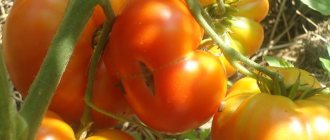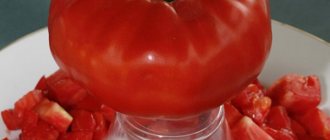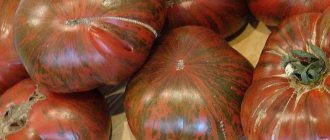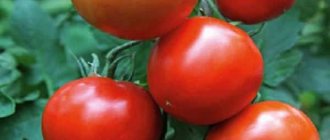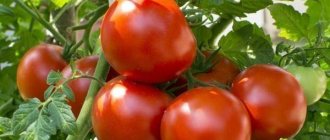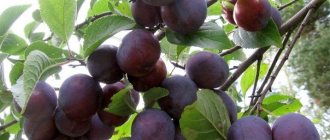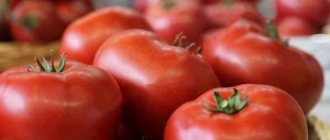Description
The variety belongs to the mid-season varieties; approximately 116-120 days pass from germination to fruit ripening. The bush is indeterminate, grows from 150 to 180 centimeters. The stem is quite strong, medium leafy, the inflorescence is simple, 3-4 fruits are formed on one. The foliage is large, dark green. The fruits are flat-round in shape, smooth, and at the ripe stage are bright red. The tomatoes are quite large, 200-350 grams. But there may be more on the lower hand. Their skin is dense, the flesh is fleshy, and has an excellent taste. With the prescribed care, you can get up to 5 kg of juicy ripe tomatoes from one bush, which is not bad.
Interesting!
During the season, the plant forms from 7 to 10 clusters.
This variety was created specifically for the Urals, but it can be planted throughout Russia. It is recommended to grow plants in greenhouse conditions. Tomatoes can be eaten fresh, added to various dishes, and can also be preserved for the winter, in the form of juice, salads, lecho and sauces.
How to select and prepare seeds for planting
When choosing tomato seeds for the Urals, it is important to correctly read the information on the packaging, because the container itself is tightly closed and there is no other way to verify the quality of the seeds and their characteristics. Moreover, the reading should rather be between the lines, since when indicating the characteristics of the species, the manufacturer tries to smooth out the negative aspects as much as possible, covering them with insignificant or dubious advantages.
“Good taste” indicates an unsuccessful hybrid with a large number of taste defects - so to speak, a product with a “C” grade. “Well transported” together with “not susceptible to cracking” - this is most likely a hard fruit, similar in density to an apple and with stringy, dry contents. The same applies to the high indicated shelf life of ripened fruits.
Even the most productive tomato varieties, which produce huge yields in southern latitudes, will disappoint the gardener of the Middle or Northern Urals. It is best to use selection specimens that have been tested in the area where they are planned to be grown.
If the gardener already has experience growing tomatoes and was pleased with the results from the previous harvest, it is best to use seeds collected by hand rather than purchased. To do this, ripe fruits are carefully selected from the strongest and healthiest bushes, and you need to take those that grew on the lowest clusters. Then the selected fruits can be removed to any place so that they can lie quietly until the tomato pulp liquefies.
Before sowing, in the spring, the seeds must be sorted, separating empty and low-quality grains. This is easy to do - dilute a 5% saline solution in a deep bowl, pour all the dried seeds into it and stir until they are well soaked. Those seeds that sink to the bottom of the bowl can be planted. The rest is collected from the surface of the water and thrown away.
The next stage is to inoculate the future plant with resistance to certain diseases, such as streaking. Such prevention is mandatory, since a tomato for the Urals in a greenhouse is exposed to many dangers that would be easier to combat in open ground.
Dressing is carried out as follows: 1 g of crystalline manganese is dissolved in half a glass of warm water and the seeds are introduced there for ten minutes. After the procedure, be sure to wash the seeds with settled water and dry them, spreading them in one layer on a napkin.
Hardening is one of the most important moments that determine the quality and volume of the future harvest. To do this, the grains are soaked in water at 18-21 C for two days, then they are transferred to ice water poured into a saucer and placed in the freezer. It is necessary to ensure that the temperature in the chamber does not fall below -3 C. After such preparation, the seeds for planting tomatoes in the Urals are ready for sowing in boxes.
Diseases and prevention
It has excellent resistance to common diseases, such as tobacco mosaic virus, but it cannot be treated and can cause significant damage to fruits. And also to fusarium and cladosporiosis. The fruits are also resistant to cracking and can be stored and transported for a long time, while maintaining an attractive appearance. But, unfortunately, there is no variety yet that is 100% resistant to late blight, so it is necessary to prevent the disease; it is much easier than treating it later.
Weather resistance
The variety tolerates temperature changes well, because it is adapted to the Ural climate, where cold snaps are not uncommon. Fruits on the bushes will be actively set even in cool and cloudy weather. “Ural” also endures overheating.
Advantages
- Large beautiful fruits.
- Great taste.
- Natural immunity to many diseases.
- Can be stored and transported.
- High yield.
- Uniform ripening.
Flaws
- It is necessary to tie the bushes to the support and remove the stepsons.
- Productivity greatly depends on growing conditions and care.
Review of the best tomato varieties for the Urals with photographs
The vast majority of our compatriots love tasty and healthy tomatoes, which have a delicious taste and good aroma. This culture has already become an integral part of the vegetable menu of many dishes, but is often eaten separately from others. However, as many people who grow tomatoes know, this crop is quite thermophilic and grows well at a soil temperature of at least +11°C. This causes some difficulties with growing tomatoes in the Urals, where summers are short and cool. Read the article: when to plant tomato seedlings?
Opportunity to grow tomatoes in the Urals
Fortunately, competent breeders have developed varieties that make it possible to successfully grow this vegetable crop even in regions with a cool climate. Thanks to this, currently everyone who lives in the Urals and nearby regions can purchase suitable seeds and grow tomatoes in their own plot. The only thing is that it is very important to choose the right seeds, and also to be confident in their good quality - after all, not only good growth, but also a bountiful harvest largely depends on the natural life-giving power of the seeds.
Agricultural technology
As stated above, this variety requires regular care; this will guarantee high yields. To plant seeds for seedlings you will need:
- Convenient container.
- Viable seeds purchased from trusted suppliers.
- Fertile soil for seedlings.
Soil is poured into the container, slightly moistened and grooves 15 mm deep are made in it, seeds are sown in them, at a distance of 2 cm. You should not reduce it, this will thicken the planting and the seedlings may stretch out. A comfortable temperature for seedlings is 18-22 degrees, the room should be well lit, it is better to place containers with seedlings on the windowsill. In the evening, it is recommended to illuminate young plants with a lamp.
Seedlings are planted in separate containers when one leaf appears. In order for it to develop faster and grow stronger, it can be fed using specialized complex fertilizers for seedlings. The optimal age for transplanting it is 55 days; if the seedlings have not reached this age or are much older, you may not get the expected result. Before planting, hardening must be carried out for 7 days.
Features of growing tomatoes in the Urals
Growing tomatoes in the Urals is accompanied by some agrotechnical rules, compliance with which will allow you to get a rich harvest of fruits:
- Landing. Tomatoes are heat-loving plants, so they need to be planted in the ground within a strictly defined time frame. Seedlings are planted in open soil after the risk of return frosts has disappeared and when the ground has warmed to a depth of 10–15 cm to 14°C, approximately at the end of May - beginning of June. In greenhouse conditions, sprouts can be planted a little earlier - in the first weeks of May.
- Watering. Regardless of the variety, tomatoes require abundant, regular moisture, the need for which is determined by the drying of the top layer of soil. The amount of watering should definitely be increased during the phase of ovary formation and fruit ripening. Two weeks before harvesting, it is recommended to stop irrigation activities in order to avoid cracking of the fruits. It is necessary to water tomatoes in the morning, evening or in cloudy weather, using settled water at ambient temperature.
- Feeding. For the full development of the crop and the formation of fruits, it must be fed three times a season: 10 days after planting the seedlings, during the flowering period of tomatoes and before the formation of fruits. It is allowed to use organic matter as fertilizers - bird droppings or manure, or mineral products based on potassium and phosphorus.
- Garter. Tall and high-yielding varieties of tomatoes require mandatory garter. The bushes are tied to special trellises or high wooden pegs, which are dug into the soil 35–40 cm.
- Formation of bushes and pinching. It is recommended to form all indeterminate types of tomatoes into one or two stems, and also regularly, every 10 days, to perform pinching, removing the lower and lateral shoots. The procedure for forming a plant can significantly reduce the load on the bush and promote more complete development of the fruit.
Despite the complexity of cultivating tomatoes in the Urals and in northern regions with poor climatic conditions, by choosing the right variety and following the main rules of agricultural technology, you can even in a greenhouse obtain high, stable yields of tasty, aesthetically attractive and extremely healthy aromatic fruits.
They are preparing for the planting season in the Urals in the fall. A fertile mixture is poured into garbage bags, which is used in the spring to grow seedlings. Compound:
- River sand, washed 1 part.
- Garden soil or soil from the garden, 2 parts.
- Mature compost (well-rotted humus) 2 parts.
Bags of prepared soil are stored in the cold. This partially disinfects it. Most of the larvae of garden pests die.
March is coming - the month when all the summer residents of the Urals take out bags of seeds. Bags of soil should be brought into a warm place earlier, already in early March, thawed, and watered with a solution of potassium permanganate. If late blight raged in the garden in the previous season, use a fungicide solution to disinfect the soil.
Sow the seeds in the ground on March 15-20. Sow in boxes, do not deepen them more than 1 cm. Cover the boxes with polyethylene and keep warm (25-28 °C) until shoots emerge. In the 2-leaf phase, plant the plants in separate cups and continue to grow at a lower temperature (18-20 °C).
Transplanting seedlings into the ground causes stress in young plants. The stress level is lower if you start hardening procedures a week before the event. If you have a greenhouse or polycarbonate greenhouse, it is easier to harden. Place the boxes with seedlings in the greenhouse. Open it during the day and cover it with covering material or straw mats at night.
Planting seedlings
Ural early is planted in the ground at the beginning of June, in a greenhouse - from late April to late May. Plantings can be done densely. Leave 30 cm between the holes. In general, stakes are not needed, but if the bushes begin to fall over due to the abundance of fruits, you can put a low peg and tie the stem to it in several places.
Water the bushes according to the weather in open ground and once every 5 days in a greenhouse. The bushes are compact and do not require large volumes of water. In the hottest weather, 0.5-1 bucket for 1 root is enough. Don’t forget to feed low tomato bushes with complex fertilizer 2-3 times a season. Choose those marked for tomatoes.
In August, the lower leaves can be gradually removed, this will make it easier for the bushes to further form fruits and prolong their fruiting. Timely harvesting of fruits that have reached milky ripeness also prolongs fruiting. Another advantage from timely harvesting is that the fruits are uniform in size.
The growing season for fruits of the nightshade family does not fit into the modest framework of the short Ural summer, so it is recommended to plant seedlings in greenhouses. Great importance is given to the choice of tomato varieties for greenhouses, which give a yield no less than related plant species grown under more gentle conditions.
Having selected a suitable variety based on the characterizing description, you need to purchase seeds from a trusted seller and begin their primary processing, which will necessarily include hardening of each seed - this procedure is all the more necessary, the more difficult the temperature conditions of the area of planned planting.
Transfer
It is better to choose a bright place for tomatoes; they love light and fertile soil; if its acidity is high, it is extinguished with lime; it is advisable to do this in the fall. The recommended planting pattern is 60 by 40; wood ash is added to the holes before planting. Since the bushes are tall, they need support, for this you can use stakes or install a trellis. You also need to remove the shoots weekly, forming plants into 1-2 stems. Approximately in the middle of the growing season, the leaves from below are removed, this will speed up the ripening of the fruit.
Like all Ural tomatoes, you need to water them regularly, but sparingly, without getting them on the leaves, after which the greenhouse should be well ventilated. Weeds are removed as they appear; row spacing must be loosened every 10-12 days. Some experienced gardeners advise mulching the soil with sawdust or grass clippings. Feeding tomatoes is also important; it should be done every two weeks, alternating organic and mineral fertilizers.
The best varietal choice
The following species presented in the description were not chosen randomly, but based on the number of positive reviews from practicing gardeners growing tomatoes in the unpredictable conditions of a short summer. The varieties were selected due to their positive relationship to the greenhouse microclimate, immunity to many diseases and productivity.
Pink honey
The species is determinate, mid-early and is used for greenhouses when planting seedlings. Of all the pink types of tomatoes, honey is the first to ripen. The yield of the species is from 3.2 to 3.7 kg of fruits per 1 m2 under conditions of proper watering and soil nutrition.
The bush is represented by a stem with a small number of dark green leaves, growing in a greenhouse up to 1.5 m in height. The recommended formation of the bush is 1-2 stems. In the first case, all the shoots are removed from the plant, in the second - all but one, formed immediately under the inflorescence. This variety is considered moderately resistant to diseases.
The fruits grow large, from 0.3 to 0.7 kg, in the shape of a heart; When ripe, the color is pink with a raspberry tint. The pulp is sugary, fleshy, suitable only for fresh consumption or for preparing first and second courses. The fruit is not recommended for canning; it does not last long and quickly deteriorates.
Caspar F1
An unpretentious determinant species for indoor soil, Caspar F1, ideal for various types of conservation and suitable for storage in boxes. The reduced susceptibility to diseases and full harvests demonstrated by the variety allow beginning gardeners to turn to its cultivation. 7-9 kg of vegetables are harvested from 1 m2.
Tomatoes have a characteristic elongated shape, reminiscent of sweet peppers; When ripe, they acquire a red color with a rich orange tint. The taste reflects a slight sourness. The fruits are small in size, weighing from 0.08 to 0.12 kg, and do not crack. The only negative that is noticeable when using fresh tomatoes is the very dense, “film-like” skin.
Bull's heart
A mid-season, determinant species for greenhouses, producing a harvest 4 months from the moment of the first shoots, while the average yield per bush in a greenhouse is within 10 kg. The bush is a tall and strong, up to 2 meters, stem formation with a small number of leaves. The formation of the 5th or 6th fruit cluster helps to stop the growth of the plant.
The brush produces 3-5 tomatoes, and the size of the fruit depends on the position of the brush on the bush - the higher the stalk is, the smaller the fruit on it. The ovary formed above the 8-9 leaf, that is, located below all, produces the largest tomatoes, up to 0.5 kg. The vegetables are heart-shaped, rich red in color, with thin, easily peeled skin.
“Bull's Heart” does not have very high resistance to disease and if the vegetable gets sick (especially late blight), it quickly affects all nearby plants.
Tornado F1
A hybrid species belonging to the mid-early, determinate varieties with a standard-type stem. The first harvest of fruits takes place 100-105 days after planting the seedlings in the soil. The yield is high, about 7 kg from each bush.
The bush grows up to 2 m, has medium spreading, which allows you to plant up to 3 plants per 1 m2. The species is not susceptible to the following diseases:
- fusarium;
- cladosporiosis;
- verticillium.
Growing Tornado F1 tomatoes is beneficial from the point of view of a commercial enterprise. The leading factor that can lead to a negative reaction is a violation of the watering regime during the period of active development.
Eagle Heart
These tomatoes for a polycarbonate greenhouse are indeterminate species with a bush height of about one and a half meters. The bushes form a powerful, densely leafed stem with small, inexpressive flowers collected in an inflorescence. The variety is resistant to diseases, but before planting it is necessary to treat the bud against insects.
With timely feeding of the soil and compliance with the irrigation schedule, this species produces within 12 kg of fruits per 1 m2. The tomatoes are very large, weighing up to 1 kg, and are attached to the stalk in no more than 3 pieces per cluster.
The use of these tomatoes in the greenhouse is universal - for making dishes, for cooking tomatoes, as part of winter salads. Due to their large size, salting whole fruits is difficult.
gold fish
The best tomato varieties for the Urals also include this unusual-looking bright orange tomato. It belongs to the mid-late indeterminates, which in the greenhouse reaches a height of two meters and must be tied up to avoid breaking the stem.
Reviews of “Goldfish” tomatoes most often note the resistance of this type of nightshade to late blight and cladosporiosis.
Early varieties of this type ripen approximately on the 85th day from the appearance of the first shoots. The plant is a squat, not spreading shrub about half a meter high with a density of up to eight seedlings per 1 m2. This plant is not very picky about lighting and tolerates temperature changes relatively well, and thanks to the early simultaneous ripening of the fruits, the fruits are harvested earlier than there is a risk of late blight infection.
When tomatoes ripen, they take on a rich red color, but grow small - about 70 g. They have a pronounced aroma and give a lot of juice.
Alaska
As with the previous species, this one offers a quick harvest of up to one hundred days from sprouting, which gives good results for cool regions with a short period of summer heat. Productivity, subject to agrotechnical standards, can reach 10 kg per 1 m2 with an average bush density of six per meter. The height of the bush is small, but due to the increased fragility of the stem, timely staking of plants is necessary.
The sprout is immune to fusarium and cladosporiosis. The appearance of the tomato is elliptical, up to 100 g. All fruits are the same in size.
